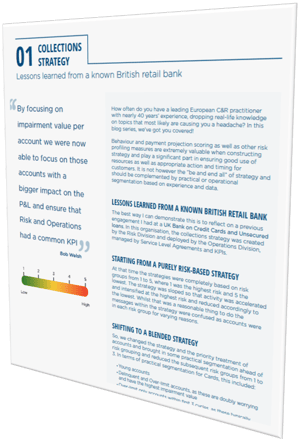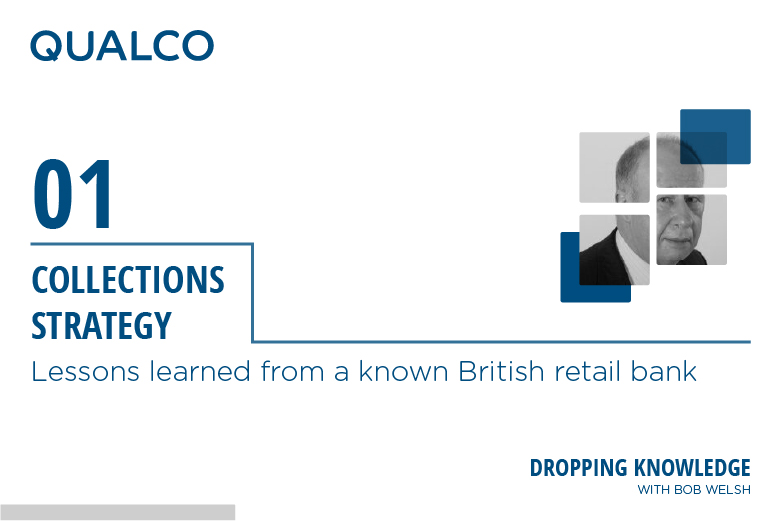DROPPING KNOWLEDGE 01: Collections strategy - Lessons learned from a known British retail bank
Bob Welsh |
How often do you have a leading European C&R practitioner with nearly 40 years’ experience, dropping real-life knowledge on topics that most likely are causing you a headache? In this blog series, we’ve got you covered!
 Behaviour and payment projection scoring as well as other risk profiling measures are extremely valuable when constructing strategy and play a significant part in ensuring good use of resources as well as appropriate action and timing for customers. It is not however the “be and end all” of strategy and should be complemented by practical or operational segmentation based on experience and data.
Behaviour and payment projection scoring as well as other risk profiling measures are extremely valuable when constructing strategy and play a significant part in ensuring good use of resources as well as appropriate action and timing for customers. It is not however the “be and end all” of strategy and should be complemented by practical or operational segmentation based on experience and data.
Lessons learned from a known British retail bank
The best way I can demonstrate this is to reflect on a previous engagement I had at a UK Bank on Credit Cards and Unsecured loans. In this organisation, the collections strategy was created by the Risk Division and deployed by the Operations Division, managed by Service Level Agreements and KPIs.
Starting from a purely Risk-based strategy
At that time the strategies were completely based on risk groups from 1 to 5, where 1 was the highest risk and 5 the lowest. The strategy was sloped so that activity was accelerated and intensified at the highest risk and reduced accordingly to the lowest. Whilst that was a reasonable thing to do the messages within the strategy were confused as accounts were in each risk group for varying reasons.
Shifting to a blended strategy
So, we changed the strategy and the priority treatment of accounts and brought in some practical segmentation ahead of risk grouping and reduced the subsequent risk groups from 1 to 3.
In terms of practical segmentation for Cards, this included:
- Young Accounts
- Delinquent and Over-limit accounts, as these are doubly worrying and have the highest impairment value
- Over-limit only accounts within first 3 cycles, as these typically migrate to delinquent and over-limit
- We also looked at Arrears > x, as this helped focus on what actually needed to be paid as opposed to balance.
After these segments were collated, the rest migrated to the appropriate risk group.
Prioritising by impairment or provision value
When prioritising these accounts, we chose to do this by impairment or provision value as opposed to balance. IFRS9 brought with it a different way of provisioning at account and not portfolio level and, of course, a balance of say 3,000 pounds may have a smaller impairment value than one of 1,500 pounds.
By focusing on impairment value per account we were now able to focus on those accounts with a bigger impact on the P&L and ensure that Risk and Operations had a common KPI.
This is hugely important as too often Risk and Operations have a different focus with one focusing on efficiency and capacity and the other on impairment.
Implementing the Strategy
Strategy was implemented as a challenger with sloping, acceleration and intensity on the practical segmented accounts as a priority followed by the respective risk groups over 3 complete cycles.With daily monitoring we had really positive results after only 20 days.
Achieving 12% reduction in new impairment
The resultant roll out as champion strategy to 100% of the collections portfolio resulted in a 12% reduction in new impairment in the financial year with an impact on the P&L of several millions.
Key Takeaways
Blending practical and scientific segmentation and building treatments accordingly around impairment value can bring substantial financial benefit in Collections strategy and helps close that bridge between Risk and Operations with a common goal.
- It’s the balance between science and operational considerations that brings the best results
- Do not simply base priority on balance but at provision or impairment value
- Have a KPI that is common to both Operations and Risk as they often work to different goals

Bio
Bob Welsh is a leading European industry practitioner in Collections and Recovery with nearly 40 years’ experience. A former Collections Executive at Bank of Scotland, RBS and Lloyds Banking Group his experience has been supplemented as a consultant with assignments at Debt Purchasers, Debt Collection Agencies and multiple sectors across Europe. From leading large, complex systems upgrades and migrations to heading up Operations and Strategy Bob is a well-respected voice in the sector.
